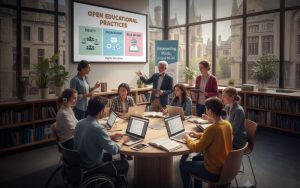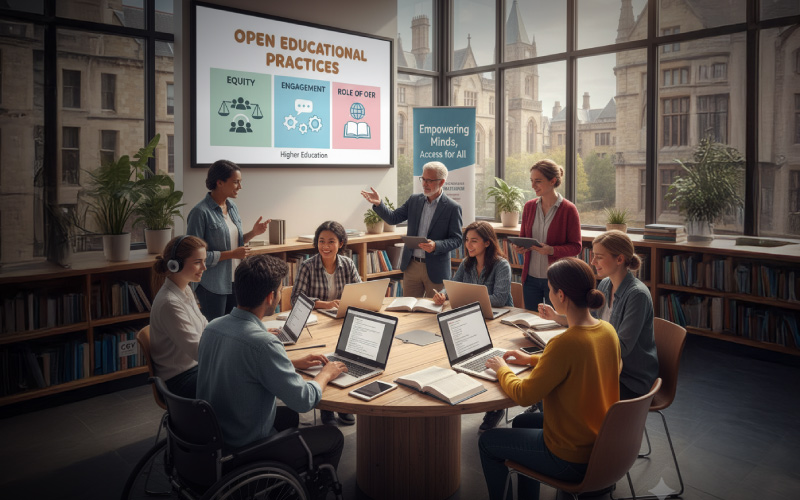For academic leaders and course designers, student engagement is a crucial challenge in the current online learning environment. Digital storytelling and rich storytelling methods have the power to turn information into unforgettable experiences, as simply providing facts in a lecture or bullet points frequently fails to captivate attention. Research shows that our brains are wired for narrative: when learners hear a story, brain regions for language, emotion, and memory all light up, whereas isolated facts only engage the language centers. In other words, embedding course material in a coherent narrative provides context and emotional hooks that make concepts easier to understand and remember. For example, a Johns Hopkins teaching innovation report notes that “building a narrative around facts provides the context that gives them meaning,” so students “are more likely to recall and retain information that resonates with them”. In higher education’s digital shift, eLearning content creation that leverages story frameworks is emerging as a powerful strategy to boost engagement and learning outcomes.
The Science of Stories in Learning
Why do stories work in learning? Cognitive psychology offers several answers. Stories naturally trigger emotional engagement: they activate the brain’s limbic system and release dopamine, which enhances memory formation. A vivid narrative, with characters and conflict, draws students in and creates a “neural coupling” between instructor and learner. Research explains that when learners follow a compelling story, they mirror the storyteller’s experience, deepening understanding through empathy.
Stories also provide a contextual framework for new information: instead of remembering an isolated principle, students tie it to a scenario or character’s journey, which fits into existing mental models. This context reduces cognitive load, since the familiar arc of a narrative helps organize knowledge more efficiently than disjointed facts. Moreover, stories spur critical thinking: when learners analyze characters’ motivations and plot outcomes, they reflect on why events unfold as they do. In practice, this means students don’t just memorize a definition; they ask “why” and “how,” weaving facts into meaning. As one educator remarked, storytelling encourages students to “think critically as they analyze characters, events, and outcomes,” thereby deepening their understanding of material. High-impact teaching strategies in higher ed (such as narrative pedagogy) acknowledge that storytelling is a proven tool for engagement: it builds learning communities and fosters a sense of self-efficacy even in online settings. In short, narrative-based design turns passive content delivery into an experience — students become active participants in a story, not merely recipients of information.
Storytelling Frameworks for Course Design
To systematically apply storytelling in college online courses, educators borrow from classic narrative frameworks. Two well-established models are the Hero’s Journey and the Three-Act Structure. Originally articulated by Joseph Campbell and re-popularized in Hollywood screenwriting, the Hero’s Journey maps out a transformational adventure: the protagonist (the student) starts in an ordinary world, encounters a challenge (call to adventure), meets mentors or resources, faces trials, and ultimately returns transformed. Instructional designers can adapt this arc to a course: for example, an introductory lesson may present a “typical workplace problem” (Ordinary World), followed by an interactive challenge revealing a skills gap (Call to Adventure).
Expert video interviews can serve as mentors, and branching simulations represent the trials and allies. Finally, a capstone project lets students apply their new abilities (the Return and Reward). An academic training blog explains the Hero’s Journey in three acts – Departure (context and call), Initiation (challenges), and Return (lessons learned) – and encourages educators to cast students as the heroes of their own learning journeys.
Similarly, the three-act structure (setup, conflict, resolution) is a universal storytelling template. In eLearning, the Setup corresponds to introducing the scenario and learning objectives, hooking students’ curiosity. The Confrontation (Act II) introduces obstacles or problems that students must navigate – this can be interactive case studies, simulations, or puzzles that build skill through practice. The Resolution (Act III) brings closure: learners apply their knowledge in a final assessment or project, and reflect on what they’ve learned. One instructional designer notes that “scenario stories incorporate aspects of traditional storytelling techniques, such as a story arc with a 3-act structure to hook the audience and make the experience more memorable”.
By structuring modules this way, even technical or abstract topics gain narrative drive. These frameworks are not just theory. Many eLearning experts advise designers to “cast the learner in the main role of the protagonist” and weave course content into a narrative arc. Elements like conflict (the problem to solve), character (whose perspective we follow), and reflection (why it matters) all appear in successful course designs.
In practice, storyboarding and scenarios are often used: designers plot out the learner’s journey in storyboard panels or flowcharts, much like plotting a movie. This ensures every module has a clear narrative purpose and a logical flow of tension and resolution.
Applying Narrative Structure to Course Modules
Putting theory into practice, an eLearning module might unfold like a short story. For example:
- Hook (Ordinary World & Call): Begin with a dramatic real-world scenario or case study that illustrates a common challenge in the field. This contextualizes the learning objectives as an “adventure” students are invited to join.
- Guidance (Meeting the Mentor): Present core content (lectures, readings, demos) framed as advice or tips from an expert or mentor character. Videos or podcasts can feature instructors in conversational modes.
- Challenges (Trials): Engage students with interactive activities, quizzes, or branching scenarios that simulate the obstacles. Providing choices and feedback lets learners feel agency – as if they are influencing the story’s outcome.
- Climax (Ordeal): Include a major assessment or project (e.g., a case study analysis or simulation) that requires applying all the accumulated knowledge and skills to “defeat” the central problem.
- Resolution & Reflection (Return): Conclude by reflecting on lessons learned. Have students compare their outcomes with experts’, discuss unexpected results, or write a reflective piece on how the experience changed their understanding of the topic.
These elements can be visualized and planned with storyboards and tables. For instance, the following table maps a Hero’s Journey structure onto a hypothetical course unit:
Scroll right to read more
| Story Stage | eLearning Module Component | Example Activity |
|---|---|---|
| Ordinary World | Introductory Scenario | A short video depicting the current state of a challenge. |
| Call to Adventure | Learning Objective Introduction | Interactive quiz revealing a skills gap. |
| Meeting the Mentor | Instructor or Expert Guidance | Video lecture or guest interview. |
| Crossing the Threshold | Core Content Delivery | Guided tutorial or animated explainer. |
| Allies & Trials | Practice and Feedback | Gamified quizzes; discussion role-play. |
| Climax (Ordeal) | Capstone Challenge | Simulation or case-study project. |
| Reward & Reflection | Assessment and Reflection | Portfolio submission; forum reflection. |
Figure: A sample eLearning scenario storyboard illustrating narrative elements (People, Setting, Challenge, Feedback). This vignette shows how a module can dramatize a workplace problem (Setting) with characters (People), pose a decision-making challenge, and provide feedback. Such story-driven scenarios make abstract content concrete and engaging.
In the figure above, a storyboard “vignette” breaks down a scenario into narrative parts: characters in a setting face a challenge, and the learner’s choices lead to feedback. This approach can be used widely. For example, some universities have students create digital stories as course assignments – combining images, audio, and narrative – to explore topics in context. Educational technologists recommend using a variety of media for storytelling. Video and podcast formats, for instance, let instructors embed narrative voice and emotions. The University of Miami has had engineering students create digital stories (using tools like Adobe Spark) around course concepts, turning each topic into a narrative exploration. Similarly, SUNY Binghamton encourages final projects that include podcasts, story maps, or video ethnographies, giving students multiple storytelling modes. Even research presentations benefit: the University of Cambridge’s “Naked Scientists” podcast series uses narrative narration to spark interest in science careers. In all cases, the goal is to make learning an immersive story, not a static lecture.
Case Studies: Digital Storytelling in Higher Education
Across the globe, higher education institutions are experimenting with digital storytelling and reporting success. In South Africa, a study at the Cape Peninsula University of Technology had final-year teacher trainees produce digital stories as part of their coursework. The results were clear: student engagement increased significantly, leading to deeper reflection and understanding of the subject matter. As one report concludes, “the production of digital stories enhanced student engagement with their studies… which led to high levels of reflection… and a deep understanding of the subject matter”. In other words, students who became storytellers learned better.
In an undergraduate health policy course in the U.S., instructors re-designed a capstone class around storytelling pedagogy. They found that the story-based approach improved student engagement, fostered knowledge creation, and even bolstered students’ sense of professional identity despite being online. These learners moved from being passive recipients to active “heroes” of their own learning journey – exactly the intended effect. Language and cultural courses provide further examples.
A University of British Columbia study integrated digital storytelling into a French-as-a-second-language classroom. Students researched cultural topics and produced multimedia stories about Francophone diversity. This intercultural narrative exercise not only engaged students but also “provided opportunities for the promotion of cultural understanding in the university language classroom”. The instructor noted that combining audio, video and animation elements helped students explore identity and culture in ways that traditional lessons could not.
Even at the K–12 level, evidence supports storytelling in learning. For instance, Malaysian pupils who created digital stories in ESL classes showed higher engagement and participation than peers in conventional classes. While not higher ed, this underscores the universal appeal of narrative: students everywhere respond when curriculum becomes a story.
Collectively, these cases illustrate that digital storytelling in course design is not a novelty but a proven pedagogy. By making learners the protagonists, educators tap into human culture’s oldest learning tool. This is increasingly recognized as a best practice; a Johns Hopkins teaching center recently hosted workshops on using storytelling frameworks (like Campbell’s Hero’s Journey) to “drive learner engagement and improved outcomes” across disciplines.
Outcomes: Narrative Design vs. Traditional Design
Adopting a narrative-driven approach can measurably affect learning outcomes. The contrast between traditional content delivery and story-based design can be summarized as follows:
Scroll right to read more
| Aspect | Traditional (Non-Narrative) | Story-Driven Design |
|---|---|---|
| Learner Engagement | Often passive – facts or slides feel abstract. Lower motivation. | Active – learners step into a story, boosting curiosity and relevance. |
| Memory & Retention | Information presented as isolated facts. Limited recall. | Facts embedded in a narrative context are easier to remember. |
| Critical Thinking | Focus on memorization; low application. | Story conflicts prompt analysis; students synthesize and apply concepts. |
| Emotional Connection | Minimal – content can feel dry or impersonal. | High – relatable characters and stakes evoke empathy and motivation. |
| Inclusivity & Relevance | One-size curriculum; may not reflect diverse perspectives. | Tailored narratives (e.g. cultural or real-world contexts) resonate with diverse learners. |
| Learning Outcomes | Primarily knowledge acquisition; transfer often shallow. | Builds deeper understanding, higher-order skills, and learner confidence. |
As the table shows, story-driven courses tend to produce better student engagement and deeper learning. When students identify with a narrative, they report feeling more connected and motivated. Studies in higher ed consistently find that courses using narrative or project-based stories see higher levels of reflection and understanding. Importantly, these benefits are strategic: engaged students are likelier to persist and succeed. By contrast, non-narrative online courses often struggle with high dropout rates, as learners feel detached.
Strategic Value for Higher Education
For institutions, embracing storytelling in elearning content creation has clear strategic value. Engaging content leads to better retention rates, positive course evaluations, and stronger learning communities. It aligns with the call for high-impact educational practices that serve diverse student populations – research suggests that underrepresented students benefit especially from inclusive, narrative-rich teaching methods.
Storytelling can also streamline course design: by planning modules as story arcs, instructional teams ensure every component has purpose and flow, avoiding disjointed “page-flipping” content. This approach also meets the moment: prospective students searching for college online courses increasingly look for interactive, media-rich learning. Institutions that highlight digital storytelling and narrative-driven pedagogy can differentiate their online programs and attract learners who crave meaningful engagement. As higher education continues evolving online, this art of storytelling in eLearning content creation will be key to raising student engagement and achieving lasting learning outcomes.
- Debdut Pramanickhttps://www.mitrmedia.com/resources/blogs/author/debdutp/
- Debdut Pramanickhttps://www.mitrmedia.com/resources/blogs/author/debdutp/
- Debdut Pramanickhttps://www.mitrmedia.com/resources/blogs/author/debdutp/
- Debdut Pramanickhttps://www.mitrmedia.com/resources/blogs/author/debdutp/









